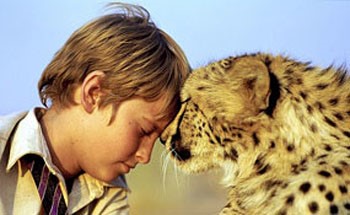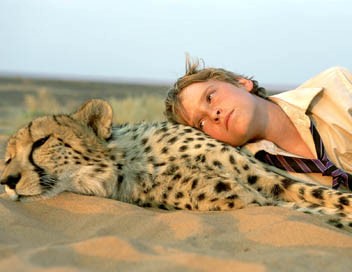Duma. Dir. Caroll Ballard. Warner Bros. Pictures. 2005.
Duma follows the narrative of a young boy named Xan embarking on an epic adventure to release his pet cheetah, Duma, to the wild. The ever-looming inevitability of Xan and Duma’s separation is the emotional core of the film, and Ballard’s depiction of their perilous journey together explores where “tame” ends and where “wild” begins.
The scene in which Duma completes his transition into the wild is full of poignant visuals, both for Xan and the audience. It is the first time we see Duma with one of his own species, the first time we see him out of the human-animal context. Perhaps most importantly, it is the first time we see Duma successfully hunt his prey and kill it; no longer can the human characters’ joke fondly about his gentle domesticity, for he is not their pet anymore. The African tribal music is upbeat, reflecting the thrill of the chase as Duma races with another cheetah, but it quickly fades out. Then, we are left with the diegetic sound of the wind gently rustling the barley, as we see Xan approach Duma hesitantly from a distance. The sudden fading out of music to an overwhelming quietness seems to represent Xan’s painful, unwilling realisation: Duma does not depend on him anymore. An underlying feeling of sadness pervades the scene as it becomes clear that their journey has reached its natural conclusion. Duma’s natural, seemingly indifferent departure into the wild is almost disappointing; it is a feeling that resonates with the argument from John Berger (2009) that “men and animals regard each other across a gulf of mutual incomprehension”.
Xan sits down, the continued quiet suddenly emphasising that for the first time in the film, he is alone. Ballard’s shot of Xan, with his back to the camera, looking out at the vast expanse of the South African wilderness furthers the sense of Xan’s sudden, overwhelming solitude. The glow of the late evening sun and the yellow-toned barley serve to permeate the scene’s aesthetic with a warm, golden hue, intensifying the sense of the bitter-sweet goodbye. Now filmed from a considerable distance, Duma could easily be a subject in a nature documentary, rather than a central character of the film; our distant view of him in his natural habitat reinforces the growing realisation that, despite our emotional connection to him, his animalism makes him fundamentally beyond human comprehension. In this shot, the same golden colours of the land juxtapose the dramatically dark blue shade of sky. The contrast is visually striking and the vivid intensity of the colours represents the potency of emotion felt by both Xan and the audience. Throughout the film, the viewer becomes accustomed to the normality of the boy and the cheetah’s friendly companionship. Ballard’s idyllic depiction of a seemingly natural bond between the two is met with, in this scene, the jarring realisation that Duma’s rightful home is, of course, in the wild. Although it makes logical sense, the separation of Xan and Duma is wrought with poignant emotion, partly because we had slightly hoped for Duma to have a greater emotional bond to his human companion. The film had, up until now, lulled us into a state of complacency in which we hoped they were friends. Or, did we simply project human qualities onto Duma in our own optimistic minds? Duma portrays an ultimately limited human-animal relationship; the overriding sentimentality felt by Xan simply cannot be reciprocated by his cheetah. Ballard explores the boundaries of human-animal relationships, advocating the possibility of a human and animal forming some level of personal connection; ultimately, though, it highlights the fundamental polarity between humans and animals.

